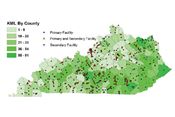Forest Industry Continues To Provide Substantial Contribution To Kentucky’s Economy
LEXINGTON, KEN.
In 2020, the Kentucky forest sector remained steady to 2019 levels and added an estimated $13.97 billion to the state’s economy.
“Tree species diversity within our forests helps buffer the sector from unknown ecologic and economic impacts, which was really important in 2020,” said Jeff Stringer, chair of the University of Kentucky Department of Forestry and Natural Resources. “The economic impact of Kentucky forests is distributed across the state and contributes to the vitality of both urban and rural economies.”
Kentucky’s forest sector is comprised of six sub-sectors: logging, primary wood manufacturing, secondary wood manufacturing, pulp and paper, paper converters and wood residue. The majority of the wood used by these sectors comes from Kentucky forests, which contain some of the largest diversity of tree species in the nation and are mostly family owned.
UK College of Agriculture, Food and Environment forestry specialists estimate that each acre of harvested woodland contributes more than $23,000 to the state’s economy. Most of this amount comes from value- added wood products produced by the secondary wood industry, but each step in the supply chain from the landowner to the final product adds to the acre’s total economic impact.
“Virtually no wood is wasted in the supply chain. Even wood residues like sawdust, chips and bark, are sold or used in other industries,” Stringer said.
As with many industries, the COVID-19 pandemic created supply chain issues in the industry. As an essential business, forest and wood manufacturing employees continued to operate throughout the pandemic.
The forest industry harvested an estimated 779 million board feet of hardwood in 2020, which is a decline of 11 million board feet compared to 2019. For many of the state’s wood species, U.S. tariffs with China imposed since 2018 negatively impacted the export market during 2020, but as the year progressed, export demand increased as these tariffs lessened.
“Slow markets, COVID-related issues and general uncertainty made 2020 another tough year for many logging operations and sawmills,” Stringer said. “If markets continue to stabilize in 2021, there are indicators of improving conditions and pricing trends.”
The state’s forests do not produce the wood species needed for the construction industry, which saw dramatic price swings throughout 2020 and at times, record lumber prices.
The demand for bourbon continues to provide a strong market for high quality white oak logs. These logs are made into barrels for the distilling and wine industries. The export market for used bourbon barrels continues to be strong. It was the state’s largest wood- related export in 2020 and accounted for $112 million.
Lower quality logs in all species declined in price as pricing softened for hardwood railroad ties. While prices dropped 13 percent in 2020 for high quality black walnut logs, which are the most valuable hardwood species, these remain at near record-high prices.
The reopening of the paper mill in Wickliffe provided an important boost to the pulp and paper industry.
“Throughout 2020, the mill ramped up production, and we are seeing a resurgence in pulpwood demand in Western Kentucky. As a result, this is providing opportunities and increased revenues for landowners in that part of the state,” Stringer said.
New to this year’s report is a breakdown of the sector’s economic impact by U.S. congressional district, which allows policymakers and the public to see the sector’s impact on each of the state’s region. The entire report is available on the UK Forestry and Natural Resources Extension website https://forestry.ca.uky.edu/economic- report/. ∆

This graphic includes the number of Master Loggers and wood-related businesses in each county and illustrates the importance of the forest industry to state's economy.